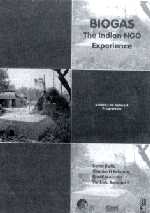Fuelling the movement
 the national programme on biogas development ( npbd ) has been one of the most high-profile renewable energy programmes of northern India. The programme, which was introduced in 1981-82, has made significant contribution in terms of providing clean and convenient fuel and fertiliser to rural families. However, the programme has had its limitations. The impact of the programme has been small and its penetration is painfully slow.
the national programme on biogas development ( npbd ) has been one of the most high-profile renewable energy programmes of northern India. The programme, which was introduced in 1981-82, has made significant contribution in terms of providing clean and convenient fuel and fertiliser to rural families. However, the programme has had its limitations. The impact of the programme has been small and its penetration is painfully slow.
Published by the Tata Energy Research Institute ( teri ), this book is an attempt to assess the impact of the biogas programme initiated by the Action for Food Production and Canadian Hunger Foundation ( afpro-chf ) network. This network comprises a total of over 100 non-governmental organisations ( ngo s) involved in promoting biogas in India since 1984. The network is spread over 14 states in India.
The book which is divi-ded into 12 chapters is full of figures, text and graphs, albeit presented in text-book fashion. In the first half of the book, the authors talk about the afpro-chf project, introducing the subject to the reader and commenting upon its achievements over the years. The second half presents the performance of the installed biogas plants and their impact on the users. The report not only deals with the performance of the plants but also with the quality of the construction material used and how repair and maintenance are carried out. The authors have made an attempt to analyse the financial arrangements, the level of technology used and the extent to which women are involved in the process. The authors have also tried to check out the weaknesses and strengths of the network and the opportunities that lie ahead for the programme.
An attempt has also been made to assess the mindset of biogas plant owners and find out why plants malfunction or operate at low efficiency. It reveals that plant owners tend to underfeed the plants and this problem is not related to the size of cattle-holding. The study also reveals that most plants function at a sub-optimal level, suffer from some manufacturing defects and the owners are unaware of how best to use them. The report highlights the economics of using biogas as a fuel. For comparing the costs of various options, an analysis was carried out for four different regions. Improvements in the quality of life, especially of women and children, as a result of using biogas, have also been noted in the study.
On an average, the authors state that a family that uses biogas spends less time in collecting firewood than one using biomass fuels. For example, a biogas user family makes 31 trips in a year for fuelwood collection, spending five hours per trip, while an ordinary family makes 40 trips in a year, spending an average of nine hours per trip.
The use of biogas has some pleasant side effects. For example, the use of the waste slurry as organic manure can yield some substantial benefits for farmers.
The authors recommend that the two key areas to be focused on are capacity building so that more units can be set up in rural areas and consolidation of the existing network.
The book documents the experience in India. Unfortunately the information has been presented in a stilted academic style and as such is hard to grasp. Nevertheless the book is must for somebody trying to understand why the biogas programme in India is not doing too well. Its problems, its potential and the thought processes of those who stand to benefit from it.
